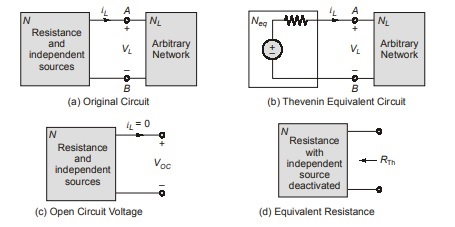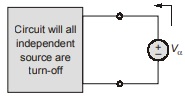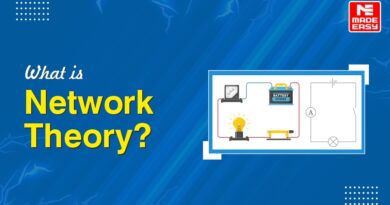Thevenin Theorem
To develop Thevenin’s theorem, consider figure consisting of two two-terminal networks, N and NL , joined at A and B. ‘N’ consist of only resistors and independent sources, whereas NL contains arbitrary even non-linear elements. Suppose NL undergoes various changes while N remains unchanged.

To simplify repeated calculations, N is replaced by a simple circuit called its Thevenin equivalent, as shown in fig. (b). The Thevenin’s equivalent consists of a single voltage source Voc in series with a single resistance RTh.
Thevenin’s theorem states that a linear two-terminal circuit can be replaced by an equivalent circuit consisting of a voltage source Vth in series with a resistor Rth, where Vth is the open-circuit voltage at the terminals and Rth is the input or equivalent resistance at the terminals when the independent sources are turned off.
Procedure to Calculate Vth :
Remove the defined load and measure its open circuit voltage as per polarity prescribed. Thus, Vth is the open-circuit voltage across the terminals as shown in fig. (c), i.e., Vth = Voc
Note:
If a circuit contains dependent sources only, i.e. there is no independent source present in the network then its open-circuit voltage or Thevenin voltage will simply be zero.
Procedure to Calculate Rth :
To apply this idea in finding the Thevenin resistance Rth, we need to consider two cases :
Case-1: When only independent source, i.e., no dependent source in the circuit.
Nullify all the independent source, i.e., (voltage source by short circuit and current source by open circuit) by doing this obtain Req (or Rth) from the open circuit load using resistance reduction method.
Case-2: When both independent and dependent source are present in the circuit. 
Nullify all independent source and keep the dependent source as it is then connect an independent voltage source Vα and current flow through it is Iα. Thevenin resistance is given as Rth = Vα/Iα
Note:
It often occurs that RTh takes a negative value. In this case, the negative resistance implies that the circuit is supplying power.
<< Previous | Next >>
Must Read: What is Network Theory?


